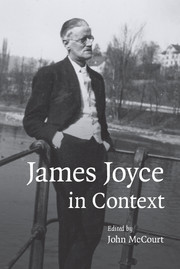Book contents
- Frontmatter
- Contents
- Notes on contributors
- Preface
- List of abbreviations
- PART I LIFE AND WORKS
- PART II THEORY AND CRITICAL RECEPTION
- 4 Genre, place and value: Joyce's reception, 1904–1941
- 5 Post-war Joyce
- 6 Structuralism, deconstruction, post-structuralism
- 7 Gender and sexuality
- 8 Psychoanalysis
- 9 Post-colonialism
- 10 Genetic Joyce criticism
- 11 Translation
- 12 Joyce and world literature
- 13 Twenty-first-century critical contexts
- PART III HISTORICAL AND CULTURAL CONTEXTS
- Further reading
- Index
10 - Genetic Joyce criticism
Published online by Cambridge University Press: 14 July 2009
- Frontmatter
- Contents
- Notes on contributors
- Preface
- List of abbreviations
- PART I LIFE AND WORKS
- PART II THEORY AND CRITICAL RECEPTION
- 4 Genre, place and value: Joyce's reception, 1904–1941
- 5 Post-war Joyce
- 6 Structuralism, deconstruction, post-structuralism
- 7 Gender and sexuality
- 8 Psychoanalysis
- 9 Post-colonialism
- 10 Genetic Joyce criticism
- 11 Translation
- 12 Joyce and world literature
- 13 Twenty-first-century critical contexts
- PART III HISTORICAL AND CULTURAL CONTEXTS
- Further reading
- Index
Summary
Joyce studies in the early twenty-first century have been marked by an important expansion of what Stan Gontarski calls the ‘grey canon’ – the extensive body of manuscripts, letters and other contextual materials, which are distinguished from the well-known ‘white’ canon of the author's published works. This colour code may seem to imply a value judgement, but it also puts the traditional canon in context and to certain extent upgrades contextual material as part of the canon's periphery. A most remarkable enlargement of this canonical banlieue was the 2002 acquisition of the Joyce papers by the National Library of Ireland, which filled a large number of lacunae, notably in the genetic dossier of Ulysses. In 2006 the NLI also acquired six sheets with very early drafts of what eventually was to become Finnegans Wake.
The importance of this extending body of prepublication materials is that it draws attention to an aspect of Joyce's work that may have been somewhat undervalued in the wake of New Criticism. The more ‘the text itself’ held the spotlight, the more it overshadowed the writing that went into it, until the work became a kind of Peter Schlemihl, a body without shadow. The prejudice that manuscript research would be tantamount to the so-called ‘intentional fallacy’ is obstinate. A search for authorial intentions may be a motive for scholars to study the manuscripts, but it is far from the only one.
- Type
- Chapter
- Information
- James Joyce in Context , pp. 112 - 124Publisher: Cambridge University PressPrint publication year: 2009



